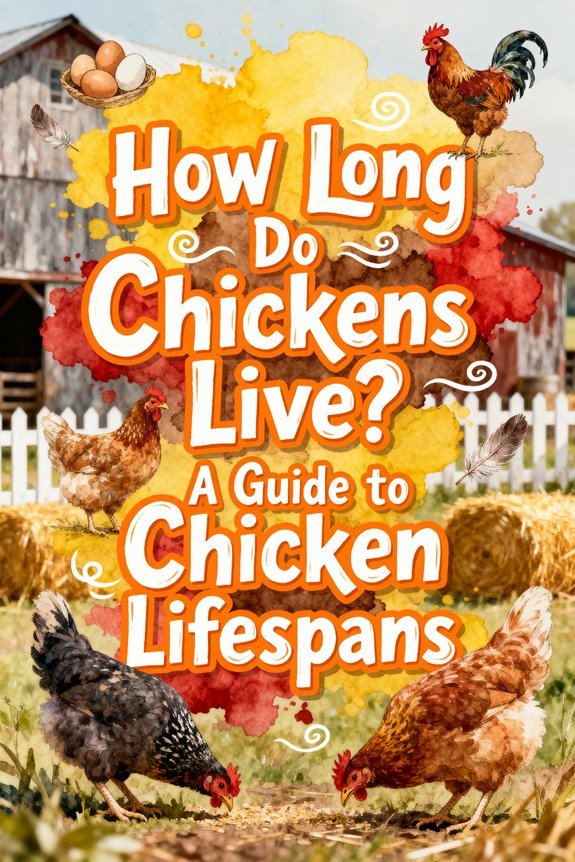How Long Until Chickens Are Fully Grown?
Your chicken’s growth timeline depends heavily on its breed. Commercial broilers like Cornish Cross reach full size in just 6-8 weeks, gaining about 61 grams daily. Heritage breeds take longer, typically maturing in 20-24 weeks with slower daily gains around 45 grams. During this time, you’ll need to adjust their feed protein levels and environmental conditions as they develop. Understanding your specific breed’s timeline will help you provide ideal care throughout their growth stages.
The Three-Week Journey From Egg to Hatch
When a fertilized chicken egg begins its development, it launches into an intricate 21-day journey that transforms a single cell into a fully formed chick. The hatch timeline starts with early embryogenesis, where you’ll see the formation of basic structures in the first three days, including heart and rudimentary organs. From days 4-7, limb buds emerge and the embryo takes its characteristic C-shape. A key indicator of proper development is the presence of ring-shaped embryonic disc in fertilized eggs.
During embryonic development between days 8-14, feathers begin forming, and the chick’s features become more defined. By days 15-18, you’ll notice the beak and claws hardening while down feathers continue growing. The final stage, days 19-21, involves the chick positioning itself for hatching, absorbing remaining yolk, and finally breaking through the shell. The hatching process itself can be a lengthy endeavor, taking up to 24 hours for some chicks to completely emerge from their shells.
First Days of Life: The Chick Stage
After hatching, newly emerged chicks require intensive care and specific environmental conditions to survive their first critical days of life. Your brooder setup must maintain a temperature of 90°F initially, which you’ll need to reduce by 5 degrees each week as they grow. Watch their behavior closely – if they huddle together, they’re too cold; if they spread out evenly, the temperature is just right. Many farmers prefer using red heat lamps as they provide consistent warmth while allowing chicks to maintain natural sleep patterns.
You’ll need to provide chick starter feed and clean water, helping them learn to eat and drink by gently dipping their beaks. During these early weeks, chicks may exhibit cecal feeding from their mother hen, a natural behavior that helps establish healthy gut bacteria. During their first two weeks, you’ll see remarkable changes as they develop from downy newborns to more active chicks. Their flight feathers will start growing around day 10, and they’ll begin establishing social hierarchies with their broodmates. Starting in week 2, you’ll want to monitor them closely as they begin to establish their pecking order which can sometimes result in injuries.
Key Milestones in the First Month
The first month of a chick’s life marks a remarkable period of rapid development and physical transformation. You’ll notice your chicks nearly double in size as they progress through several key growth milestones. Their initial down feathers give way to pin feathers, eventually developing into juvenile plumage by week four.
Most chicks from stores like Tractor Supply are one to two days old when purchased, requiring extra attention during these early stages. In the brooder environment, you’ll need to gradually reduce the temperature from 95°F to about 75°F as your chicks develop their temperature regulation abilities. A brooder helps ensure optimal immune health and disease prevention in chicks without maternal care. They’ll shift from fragile hatchlings to more independent birds, establishing their pecking order and displaying complex social behavior. During this time, it’s essential to maintain proper nutrition with specialized chick feed and monitor their development closely. Watch for steady weight gain, increasing mobility, and healthy feather development throughout this vital period.
Understanding the Pullet Phase
During the pullet phase, your young chickens undergo dramatic transformations as they progress from chicks to mature birds. This vital stage spans from 6 weeks to 6 months of age, marking a period of rapid pullet development and significant physical changes.
You’ll notice your birds developing their adult feather patterns through multiple partial molts, while their skeletal structure and muscles grow substantially. For laying breeds, you can expect them to reach egg-laying maturity around 18 weeks of age. Social behavior becomes more complex as they establish pecking orders and flock dynamics. Quality commercial feeds from trusted brands like Purina and Nutrena help ensure proper nutrition during this critical stage. To support healthy growth, shift their feed from starter to grower ration with 16-18% protein, and later to pre-layer feed with increased calcium levels. At around 16-18 weeks, transition pullets to a complete layer feed that provides essential calcium and protein for optimal egg production.
Maintain proper lighting schedules of 10-12 hours initially, gradually increasing to 14-16 hours to regulate sexual maturity. Provide adequate space to prevent stress and guarantee uniform development throughout this important phase.
Physical Changes From Week 6 to Month 6
From week 6 to month 6, your chickens undergo five major physical transformations that signal their progression toward maturity. You’ll notice primary feathers becoming prominent around weeks 5-6, with distinct gender patterns emerging by week 15. Your birds’ size will increase dramatically, requiring double the floor space. During this time, it’s crucial to maintain twice the floor space to accommodate their rapid growth between weeks 6 and 8. Watch for behavioral maturation as they establish pecking orders and develop essential instincts like foraging and dust bathing. During this phase, you’ll need to provide starter-grower feed with 18% protein to support their rapid development. As they approach month 6, you’ll observe changes in combs and wattles, especially in pullets preparing for egg production. Their bodies will reach near-adult size by week 20, with females showing signs of reproductive readiness. Most pullets will reach egg laying age between 18-22 weeks, marking their transition to full maturity.
Reaching Adult Size and Maturity
While most chickens approach full adult size between 18-24 weeks, you’ll notice significant variations based on breed and environmental factors. Heavy breeds like Brahmas may take up to 12 months to reach their full potential, while lighter breeds develop more quickly. During early development stages, Brahmas require special attention to maintain strong leg development.
You’ll recognize several key maturity indicators as your chickens develop. Hens will begin laying eggs around 20-24 weeks and display characteristic squatting behavior. Rhode Island Reds are known for their early egg production, starting as soon as 18 weeks of age. Peak egg production can last up to two years with proper care. Roosters typically start crowing between 4-6 months. Watch for the development of pronounced sexual characteristics, including larger combs and wattles. You’ll also observe more defined social hierarchies and consistent daily routines.
Physical markers of adult size include robust chest development, loss of adolescent awkwardness, and complete adult plumage. Even after reaching full size, your chickens may continue refining muscle distribution for several months.
Factors Affecting Growth Rate
Several key factors work together to determine how quickly your chickens reach maturity, with genetics playing a foundational role. Through genetic enhancement, modern broilers grow considerably faster than heritage breeds, setting the baseline for growth potential.
Environmental impact plays an essential role in realizing this genetic potential. You’ll need to maintain ideal housing conditions with proper ventilation, temperature control, and appropriate stocking density. A well-designed predator-proof coop provides the security needed for optimal chicken development. Your birds’ nutrition is equally important – they require balanced feed with the right mix of grains, proteins, vitamins, and minerals. Adding apple cider vinegar to their water can improve nutrient absorption and digestive health. The inclusion of digestive enzymes helps maximize nutrient absorption. The data shows that flocks between 11,000 to 30,000 birds achieve optimal growth rates and performance outcomes.
Incubation conditions also influence growth rates. You’ll get the best results by maintaining precise temperature (38.7°C) and humidity levels during hatching, as early development sets the foundation for future growth performance.
Essential Care During Development Stages
Now that you understand what drives growth rates, proper care throughout each development stage becomes the cornerstone of raising healthy chickens. Temperature management is critical – start brooder temps at 95°F and decrease by 5°F weekly. You’ll need to adjust feed protein levels from 18-20% during the chick stage to 14-16% for pullets, then shift to layer feed with added calcium around 16-18 weeks. Adding small marbles to water containers prevents accidental drowning of young chicks.
Environmental enrichment plays a crucial role in development. Provide clean bedding, perches, and dust baths to encourage natural behaviors. Handle chicks regularly for socialization, and introduce them gradually to the flock at 6-8 weeks. Regular monitoring of coop crevices can help detect early signs of mite infestations that could impact growth. Maintain strict biosecurity through daily cleaning, monitor for illness, and guarantee proper ventilation without drafts. Don’t forget fresh water and appropriate space allowances as your birds grow. During weeks 5-15, chickens will develop their primary feathers and begin showing distinct physical characteristics.
Breed-Specific Growth Timelines
Different chicken breeds follow distinct growth patterns that greatly impact their time to maturity. Fast-growing Cornish Cross birds reach market weight in just 42 days, gaining about 61 grams daily, though this rapid growth can affect meat quality and bone development. Heritage breeds like Jersey Giants and Delawares take a slower path, gaining around 45 grams per day and maturing in about 57 days for basic market weight.
You’ll find medium-growth breeds, such as Freedom Rangers, offer a middle ground with breed characteristics that balance growth rate and hardiness. These birds typically reach full size in 8-12 weeks, making them ideal for pastured operations. When choosing your breed, consider that while Cornish Cross delivers quick results, heritage and medium-growth breeds often provide better foraging abilities and overall health. Modern breeding techniques have created chickens that are more feed efficient, converting food to meat at unprecedented rates compared to historical breeds. Commercial broilers are harvested well before sexual maturity, which normally occurs around 20-24 weeks of age.
Optimal Nutrition for Healthy Growth
Proper nutrition stands at the core of raising healthy chickens, regardless of their breed or growth rate. You’ll need to provide a balanced diet that changes with their developmental stages. During the first six weeks, your chicks require 18-24% protein to support rapid growth, with meat breeds needing the higher end of this range.
As your chickens mature, you’ll adjust their protein levels downward – about 16-18% during the grower phase and 15-17% during development. For maximum growth efficiency, make certain their feed contains essential amino acids like lysine and methionine. You’ll also need to carefully manage calcium levels, starting low at 0.8-0.9% and increasing to 2.0-3.5% as pullets approach laying age. Remember that proper energy levels of 2700-3000 kcal/kg support healthy development throughout all growth stages. Once chickens reach 20 weeks, switching to a layer feed becomes essential for optimal egg production. For consistent egg quality, ensure your hens have free-choice access to their complete feed while limiting treats to maintain proper nutrition.



